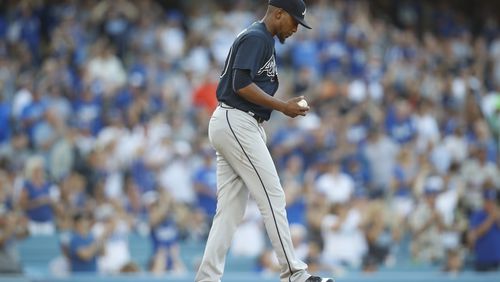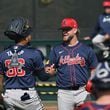Baseball-Reference's home page for the 2017 Atlanta Braves includes the photos of the team's 12 most valuable players as rated by B-Ref WAR. Not pictured: Julio Teheran.
Of the five pitchers taking turns in the Braves' rotation, their Opening Day starter has been – again by B-Ref WAR – the fourth-best. (And that's by a hair. Teheran is at 0.4; Sean Newcomb, whose first start came June 10, is at 0.3.) Among big-league pitchers who've worked 100-plus innings, Teheran ranks among the bottom 20 in ERA, WHIP and WAR . A year ago, we wondered if he was indeed a No. 1 starter ; this year would barely qualify him as a No. 4.
Teheran, 26 and twice an All-Star, is on pace to have his worst season via every significant metric since establishing himself in 2013. In none of those categories is there a gentle dip. His worst ERA over the previous four seasons was 4.04 in 2015; this year it's 4.97. His worst home-runs-per-nine-innings rate was 1.2, also in 2015; this year it's 1.8. His worst strikeout-to-walk ratio was 2.34, also in 2015; this year it's 1.91.
There was thought that Teheran's issues two seasons ago were due to an overreliance on his two-seam fastball, or sinker. Roger McDowell, then the Braves' pitching coach, had built his playing career on the sinker. But McDowell now works in Baltimore, and here, per Brooks Baseball, are Teheran's two-seamer usage rates:
2015 (bad year): 19.25 percent.
2016 (All-Star year): 9.53 percent.
2017 (bad year, at least so far): 22.71 percent.
Some among the Braves' elders – and not just in this administration; in Frank Wren's, too – believed McDowell and Teheran weren't a harmonious pairing . If we go by results, Chuck Hernandez has been no remedy. To be fair, Teheran's ERA has dropped from 5.40 to 4.67 over the past six weeks, and he did just have a run of six quality starts in seven turns. But it's noteworthy that general manager John Coppolella, asked last summer, about the availability of his best pitcher, said: "We aren't trading Julio." There has been no such proclamation this time.
The trade deadline is a week away. The Braves’ playoff chances, never strong, took a hit over a 2-5 week. The almost-but-not-quite trade of Jaime Garcia to Minnesota suggests Coppolella is, as we all figured he’d be, in sell mode. And so we ask again: Should the Braves trade Teheran?
He’s still an attractive lure – a 26-year-old former All-Star with no history of arm trouble who has taken a regular big-league turn for 4 3/5 seasons and who’s due to make $8 million next season and $11 million in 2019, with a team option for 2020 at $12 mil. That’s cheap for even a No. 4 starter. (The Braves paid Bartolo Colon $12.5 million for this season.) At his best, Teheran can be better than a No. 4, which by rights would make him a steal.
Loaded words: “At his best.” He has only intermittently been that in 2017 – started well, went bad, better of late. This time last year, the Red Sox were believed to have interest in Teheran. Had Coppolella dangled Teheran last summer, the asking price would have been Mookie Betts, who finished second in the American League MVP voting, and Xander Bogaerts, who’s an All-Star shortstop. That’s how overheated the market was. It’s cooler now.
In 2016, the Braves keeping Teheran was a no-brainer. (Unless they’d have gotten Betts/Bogaerts, which would have shown no brains on Dave Dombrowski’s part.) In 2017, there’s no kneejerk answer. Teheran’s season has given his team cause to consider life beyond him.
Reasons to keep him: He's still young, still cheap, still healthy, still possessed of a five-pitch repertoire. Also: None of the pitchers drafted the past three Junes – Wright, Anderson, Wentz, Allard and Soroka – figure to be here within the next calendar year.
Reasons to move him: These substandard stretches are what separate top-of-the-rotation starters from the No. 3s and 4s. Teheran has a new pitching coach, which means the McDowell issue is moot, but through 97 games has had his worst season. His FIP – fielding independent pitching – is 5.52. (As a Brave, Colon's was 5.09.) When your FIP is lower than your ERA, it's a sign you might have been a tad unlucky. When your FIP is worse, it's a warning light.
Also this: SunTrust Park plays small. Teheran is a fly-ball pitcher. He has yielded 13 home runs in 10 home starts against 10 in 10 on the road. Opponents are slugging .509 against him in Cobb County, .403 elsewhere. His ERA splits – 7.05 here, 2.70 there. That mightn't be a blip. That might reflect new geographic reality.
Conclusion: Given that Teheran in a down year isn't apt to reap a windfall return, I wouldn't trade him this month. But I'd be concerned that the window for moving him is shrinking, and I'd look hard over the winter.
About the Author







